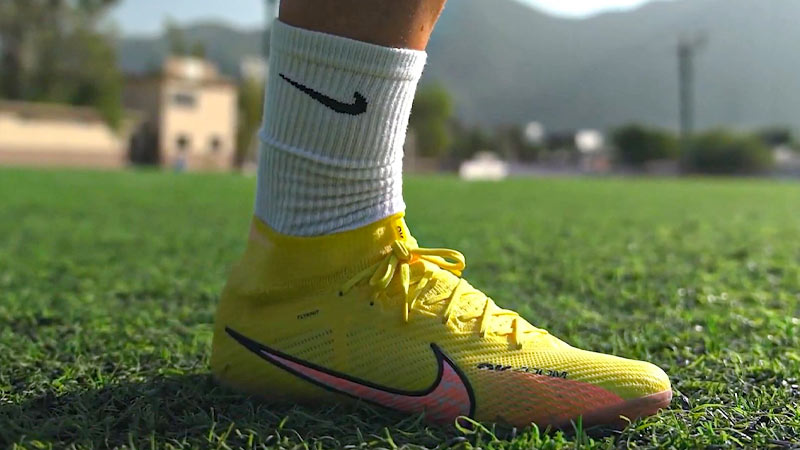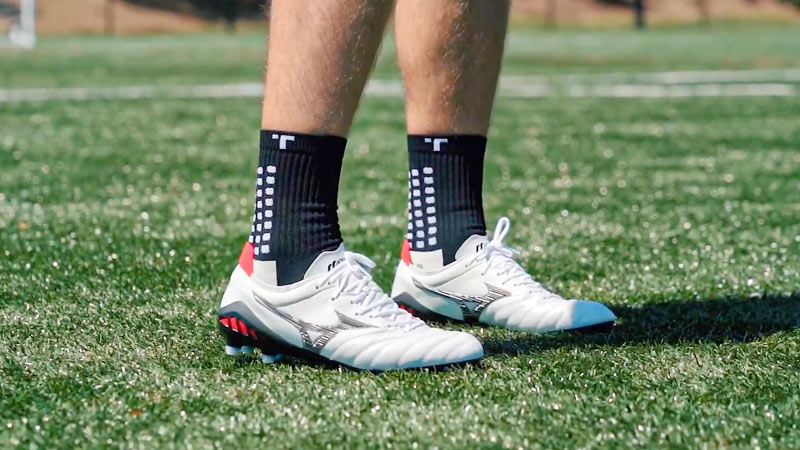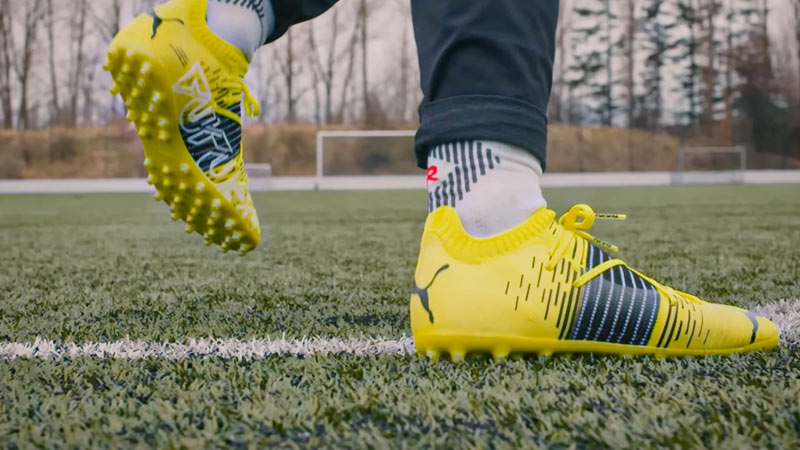Navigating the choice of footwear on turf involves critical considerations for both performance and safety.
The compatibility of plastic cleats with the synthetic composition of turf fields raises questions about their suitability.
This inquiry delves into the potential challenges of wearing plastic cleats on turf, examining issues such as traction deficiencies, durability concerns, and increased injury risks.
As the sporting community seeks the ideal balance between optimal play and surface preservation, understanding why plastic cleats may not be the best choice for turf fields becomes essential.
This exploration underscores the importance of selecting footwear tailored to the specific demands of artificial surfaces in sports and recreational activities.
Can You Wear Plastic Cleats on Turf?
Wearing plastic cleats on turf is ill-advised due to traction deficiencies, durability concerns, and increased injury risks.
The rigid plastic studs are unsuitable for the synthetic surface, potentially causing damage and violating field regulations.
Opting for turf-specific footwear ensures safety, longevity, and compliance with playing surface guidelines.
Here are the facts that will tell you whether should you wear plastic cleats on turf or not:
Traction Issues

Plastic cleats, designed for natural grass surfaces, struggle to adapt to the unique composition of turf.
Unlike natural grass where plastic studs can dig in, turf’s artificial grass blades and rubber infill create a less forgiving surface.
Plastic cleats lack the necessary grip, making it challenging to achieve proper traction.
This deficiency becomes particularly evident during quick sprints, abrupt stops, or sharp turns, increasing the likelihood of slips and falls.
Durability Concerns
Turf surfaces, characterized by their abrasive nature, can expedite the wear and tear on the studs of plastic cleats.
Unlike the sturdier construction of metal or rubber cleats, plastic studs may not withstand the constant friction and pressure exerted on them during play on turf.
The result is a diminished lifespan of the cleats, potentially making them a less cost-effective and reliable option for turf sports.
Injury Potential
The compromised traction and potential cleat damage on turf elevate the risk of injuries. Slips on the surface can lead to common sports injuries such as sprained ankles or muscle strains.
Additionally, the inadequate grip may impede the athlete’s ability to execute precise maneuvers, increasing the chances of accidental twists, turns, or hyperextensions, with potential repercussions for joints and ligaments.
Surface Damage
Turf fields are substantial investments in terms of installation and maintenance costs. Wearing plastic cleats on turf can contribute to unnecessary wear and tear.
The rigid plastic studs are not optimized for synthetic surfaces, and prolonged use can cause damage to the turf, affecting its playability, aesthetics, and overall longevity.
Protecting the integrity of the turf is not only in the interest of player safety but also a means of preserving the quality of the playing surface.
Compliance with Regulations
Many sports organizations and facilities have stringent guidelines regarding footwear to be used on turf fields.
Wearing plastic cleats when they are explicitly prohibited can lead to penalties, fines, or even denial of access to the field.
Adhering to these regulations ensures fair play, maintains the quality of the turf, and promotes a safe environment for all participants.
Suggestions for Wearing Cleats on Turf
When gearing up for sports on turf surfaces, strategic considerations in selecting and wearing cleats are paramount for optimal performance and safety.
Here’s a closer look at what to consider for wearing cleats on turf:
Turf-Specific Cleats

Invest in cleats explicitly designed for turf. These shoes are crafted with the unique characteristics of artificial surfaces in mind.
Turf-specific cleats typically feature shorter, rubberized studs that offer reliable traction without compromising the integrity of the playing field. This tailored design optimizes grip and minimizes wear and tear on the turf.
Low-Profile Studs
Prioritize cleats with low-profile studs. The shorter length of these studs strikes a balance between providing necessary traction and avoiding excessive penetration into the turf.
This design facilitates quick movements, sudden stops, and precise changes in direction, contributing to enhanced agility and overall on-field performance.
Rubber or TPU Studs
Look for cleats equipped with studs made of rubber or thermoplastic polyurethane (TPU). These materials offer a resilient and durable option for turf play.
Unlike plastic, rubber or TPU studs provide superior grip on synthetic surfaces while withstanding the abrasive nature of turf, ensuring longevity and performance.
Comfort and Fit
Prioritize comfort and proper fit when selecting cleats. Optimal arch support, cushioning, and a secure fit contribute to overall stability.
Cleats that fit well reduce the risk of discomfort, blisters, and potential injuries during prolonged periods of play.
Consider the Sport
Different sports may dictate specific cleat requirements based on the nature of the game. For instance, soccer cleats may prioritize lateral movement, while football cleats may focus on traction and stability during quick sprints.
Align your choice of cleats with the specific demands of the sport you are engaging in on the turf.
Check Field Regulations
Familiarize yourself with any regulations governing footwear on the turf field. Some facilities or sports organizations may have strict guidelines regarding cleat types.
Ensuring compliance with these regulations is essential to avoid penalties or restrictions on-field access.
Regular Maintenance
Cultivate a habit of regular cleat maintenance. After each use, clean off dirt and debris, and inspect the studs for signs of damage.
Promptly replace worn-out or damaged cleats to preserve optimal performance and reduce the risk of injuries associated with compromised footwear.
Breaking-in Period
Allow for a breaking-in period with new cleats. Wear them during practice sessions before engaging in competitive play to ensure they adapt to your foot shape and provide the necessary comfort and support.
This gradual introduction helps prevent discomfort and potential blisters during critical game moments.
Carry an Extra Pair
Consider having a spare pair of cleats on hand, especially for longer tournaments or events. A backup set ensures flexibility to switch out cleats if they become uncomfortable or if unexpected damage occurs during play, preventing disruptions to your performance.
FAQS
Should I Wear Cleats on the Turf?
It’s advisable to wear turf-specific cleats designed for synthetic surfaces. Regular cleats, especially those with plastic studs, may lack traction and pose safety risks on turf.
Can You Use Cleats on Turf?
Yes, but it’s recommended to use cleats specifically designed for turf. These cleats typically have shorter, rubberized studs to provide better traction on artificial surfaces.
Can You Wear Cleats on Turf?
Yes, wearing cleats on turf is common, but it’s essential to choose the right type. Turf cleats are designed to optimize performance and safety on synthetic fields.
Do You Wear Cleats on Turf?
Yes, athletes often wear cleats on turf. However, using the appropriate turf-specific cleats is crucial to prevent slips, injuries, and damage to the playing surface.
Is it OK to Wear Cleats on Turf?
Yes, it’s generally acceptable to wear cleats on turf. However, it’s crucial to use cleats specifically designed for turf to ensure optimal performance and safety.
Can You Wear Football Cleats on Turf?
Yes, you can wear football cleats on the turf. It’s recommended to choose football cleats designed for turf surfaces, featuring shorter, rubberized studs to provide better traction and prevent damage to the turf.
To Recap
The choice of footwear on turf extends beyond personal preference, encompassing critical factors influencing both player safety and field integrity.
The unsuitability of plastic cleats for synthetic turf becomes evident when considering issues of traction, durability, and potential for injuries.
As this discussion emphasizes the importance of adapting equipment to specific playing surfaces, it underscores the significance of turf-specific footwear.
Opting for cleats designed for turf ensures not only enhanced performance and reduced injury risks but also contributes to the longevity of the playing surface.
Ultimately, a well-informed decision on footwear emerges as an integral aspect of a safe and enjoyable experience on turf.







